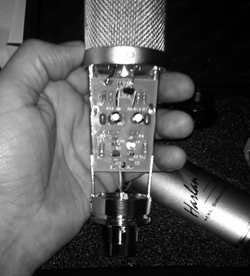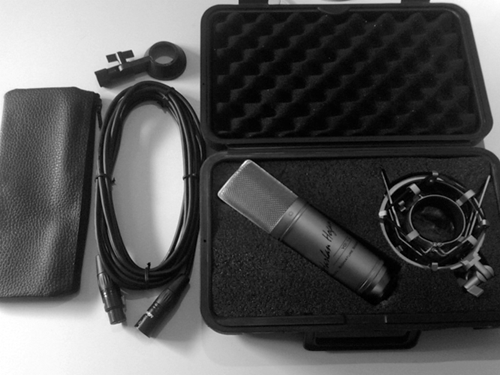
THE SPECS
This mic’s claimed frequency response is from 30 Hz to 20 kHz, with a sensitivity of 18mV/Pa, which is typical for this class of microphone.
It does have a frequency bump in the high-end, which I’ll discuss in a moment. The maximum SPL is rated at 130 dBSPL which is not as high as some, but perfectly adequate for any voiceover job. The microphone’s equivalent input noise is 16dBA; this is not as low as it might be, but is quite respectable and is in fact lower than several other well-known brands in this price range. The overall signal-to-noise ratio comes in at 78dB (A-weighted).
Physically, the VO:1-A appears closest to the MXL992 cardioid microphone, which also features a 32mm capsule. Unlike the 992, the VO:1-A is a straightforward, no-frills microphone that has no external pad or low-frequency roll off switches. As it turns out, it needs neither.
So what is different about the VO:1-A from other MXL studio microphones? What allows it to claim that it is designed specifically for voiceover performers? There are few differences relative to other microphones from MXL. It’s been my experience that most MXL condenser microphones have a significant bump in presence at around 8 to 10kHz. The VO:1-A is no exception, as its frequency response rises at 9kHz. However, the rise is a smooth one rather than a peak or a jump in the high frequencies. Low frequencies actually roll off smoothly, beginning right around 100Hz.
In use the microphone provides a nicely balanced sound with a bit of high-end crispness, but much less than I have found in other MXL microphones. The low-end is present and certainly meaty enough for Big Voice male voiceover, but the proximity effect was not nearly as pronounced as I had expected it to be. Curious as to how this was possible, I checked the polar pattern chart included with the microphone. While the VO:1-A is certainly a cardioid condenser, its polar pattern veers toward being omnidirectional.
This would explain the microphone’s lack of proximity effect. True omnidirectional microphones have no proximity effect, since that effect is generally a byproduct of how cardioid mics create their polar pattern. Cardioid dynamic microphones are ported in such a way that sounds arriving from the side of the capsule are partially canceled out by sounds reaching the capsule from the front. Cardioid condenser microphones mimic that porting process in the way the diaphragm and plate are electrically charged, but the result is fundamentally the same. In both cases, the amount of cancellation of low frequencies is greatly reduced when the sound source is very close to the capsule, hence the bass boost one gets when one is closer than 12 inches from the microphone’s diaphragm.
This is not to say that the VO:1-A has no proximity effect. It will in fact get suitably big if you get right up on the capsule. I would instead say that it’s probably more forgiving for inexperienced talent who haven’t yet mastered the use and control of proximity. The same cannot be said for plosives; this microphone has a high enough sensitivity that plosives will still bite you in the butt if you’re not using a suitable pop filter.
I had several opportunities to test the VO:1-A with both male and female voice talent. Overall, I would have to say that I preferred the VO:1-A over several of the mics in this price range that I have recommended to voice talent in the past. Yes, the slight presence bump is evident. One female voice artist with whom I work regularly has a sibilance issue. I expected she might have a problem with the VO:1-A in that regard, and indeed she did. But she was the exception -- I recorded two other female talents, and that same presence bump imparted a rather pleasant sheen to their tracks. Male voice talent sounded universally good. The low midrange response of the VO:1-A is solid without being in any way tubby. The microphone handled high energy, high volume reads with aplomb, never getting harsh or crashy with them.
I connected the microphone to both tube and solid-state preamplifiers, and it required no more gain than I would’ve expected of a phantom powered condenser microphone. Right around 30dB of gain resulted in a strong, healthy signal level for all but the intimate reads. Since the mic does have some character of its own, I preferred using the solid-state FMR Really Nice Preamp as a front end, although it also sounded quite good through the preamps in a standard issue Digidesign Mbox 2.
Self-noise in this microphone appeared to be on par or slightly better than other sub-$200 microphones I have tested. In particular, the VO:1- A is noticeably quieter than the Audio Technica AT2020, a microphone I had recommended to students on many occasions. But for general voiceover work, including soft and intimate reads, noise was not an issue during my evaluations. It should be noted that there are many postings on recording forums regarding modifications to MXL microphones that allegedly improve their noise performance. These modifications were quite popular with owners of earlier versions of MXL products. But the company has improved the overall noise performance of their microphones across the board in the past few years.
Finally, the VO:1-A is not is not a color-free microphone. It does have a personality, one that I found in most cases to be flattering on voiceover tracks. The combination of solid but controlled low end along with some high-end sheen was usually exactly what the doctor ordered.
As mentioned earlier, the VO:1-A has a bit of heft that is not in any way heavy. This turns out to have a benefit that never occurred to me -- I’ve set up a number of home studios for voice actors, and many of them like to work with the desktop mic stand topped by a short boom.
It is often the case that extending even a 12-inch boom causes the stand to become unstable when you’ve mounted the mic on it. The weight of the VO:1-A is just about right so that does not occur. Nicely done.

The information page for this microphone on Harlan’s website features a link that promises more information on a USB version of the VO:1-A. I was apprehensive when I saw the link, since many USB microphones are inferior to their standard XLR cousins... the noise performance is normally significantly worse. So I was pleased to see that there is no USB version of VO:1-A; rather, Harlan recommends the MicPort Pro USB to XLR converter. This is the only converter of which I’m aware that actually sounds good, and would make a killer addition for a travel rig that included the VO:1-A.
Currently the only way to acquire one of these microphones is directly from Harlan Hogan’s voiceoveressentials.com website. As a voice actor Harlan obviously understands that choosing a mic is a very personal process, so he offers a generous refund policy to give artists time to audition the microphone, in addition to MXL’s three-year warranty. The VO:1-A carries suggested retail price of $199 US. For more information worldwide, visit www.voiceoveressentials.com.
♦

